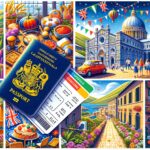As the world gradually opens up for travel amidst the COVID-19 pandemic, many Americans are wondering whether they can travel to Italy in July. With its stunning landscapes, rich history, and delicious cuisine, Italy continues to be a popular tourist destination for Americans. In this article, we will explore the entry requirements, travel restrictions, safety measures, popular attractions, transportation options, accommodations, local events and festivals, as well as essential travel tips for Americans planning to visit Italy in July.
Before packing your bags and heading to Italy in July, it’s important for American travelers to be aware of the entry requirements set by the Italian government. Additionally, it’s crucial to stay updated on any changes or updates related to these requirements in light of the evolving pandemic situation.
Italy has imposed certain travel restrictions for American tourists due to the COVID-19 pandemic. Understanding these restrictions is essential for anyone planning a trip to Italy in July. By being well-informed about the current situation in Italy, American travelers can make necessary arrangements and adjustments for their visit.
Furthermore, we will also cover the COVID-19 safety measures and protocols that American travelers need to follow while visiting Italy in July. From mask mandates to social distancing guidelines, being familiar with these protocols is crucial for a safe and enjoyable trip. As we navigate through these challenging times, understanding and adhering to these safety measures is imperative for both travelers and locals alike.
Current Travel Restrictions in Italy for American Tourists in July
As of July, Italy has implemented certain travel restrictions for American tourists due to the ongoing COVID-19 pandemic. At this time, entry into Italy is allowed for American travelers who have been fully vaccinated with an approved vaccine or who have tested negative for COVID-19 within a specified timeframe before their arrival.
It’s important to note that these requirements are subject to change, so it is recommended to stay updated with the latest information from the Italian government and embassy.
In addition to vaccination and testing requirements, American tourists traveling to Italy in July will need to fill out a digital passenger locator form and may be subject to health screenings upon arrival. It is also advisable for travelers to check if there are any specific regulations or restrictions in place for the region they plan to visit within Italy.
Despite these restrictions, Americans can still travel to Italy in July as long as they adhere to the entry requirements and follow the necessary precautions.
Furthermore, it’s crucial for American tourists planning a trip to Italy in July to stay informed about any changes or updates related to travel restrictions. The situation regarding international travel continues to evolve, so it’s essential for travelers to monitor official sources of information and seek guidance from reliable sources such as the Centers for Disease Control and Prevention (CDC) and the U.S. Department of State before making any travel plans.
COVID-19 Safety Measures and Protocols in Italy for American Travelers in July
As of July, 2021, Italy has implemented several COVID-19 safety measures and protocols for all travelers, including American tourists. It is important for Americans traveling to Italy in July to be aware of these regulations in order to have a safe and enjoyable trip.
Mask Mandates and Social Distancing
One of the most prominent safety measures in Italy is the enforcement of mask mandates in indoor public spaces and on public transportation. American travelers should be prepared to wear masks at all times when indoors or while using public transportation. Additionally, social distancing protocols are still in place throughout Italy, so tourists are advised to maintain a safe distance from others while visiting attractions or dining at restaurants.
COVID-19 Testing and Vaccination Requirements
As of July 2021, Italy requires all incoming travelers from the United States to provide proof of a negative COVID-19 test taken within 72 hours before arrival. Additionally, fully vaccinated American tourists can also enter Italy without quarantine requirements upon presenting their vaccination certificates. It is important for travelers to stay updated on any changes in testing and vaccination requirements before their trip.
Health and Safety Guidelines at Tourist Attractions
Tourist attractions and popular destinations in Italy have implemented health and safety guidelines to ensure the well-being of visitors. This may include limited capacity at museums and landmarks, mandatory temperature checks at certain venues, and enhanced sanitation measures. American tourists should check individual attraction websites or contact tourist information centers for specific guidelines before visiting popular sites.
Overall, as of July 2021, Americans can travel to Italy with proper planning and adherence to COVID-19 safety measures. By staying informed about entry requirements, following health protocols, and being mindful of local regulations, American tourists can experience the beauty of Italy while prioritizing their health and safety during their visit.
Popular Tourist Destinations and Attractions in Italy to Visit in July
Italy is known for its rich history, stunning architecture, and delicious cuisine, making it a top destination for travelers from around the world. In July, American tourists can look forward to exploring some of the most iconic attractions and destinations in Italy.
One of the must-visit cities is Rome, home to famous landmarks such as the Colosseum, Vatican City, and the Trevi Fountain. Visitors can also explore the historic city of Florence, known for its Renaissance art and architecture, including the renowned Uffizi Gallery and the Florence Cathedral.
For nature lovers, a visit to the Amalfi Coast offers breathtaking views of rugged cliffs, sparkling blue waters, and charming seaside towns. The beautiful island of Sicily with its ancient ruins and stunning beaches is also a great option for those seeking a mix of history and leisure. Additionally, Venice with its picturesque canals and vibrant culture is a unique destination that should not be missed.
Visitors should also take advantage of Italy’s diverse landscapes by visiting the rolling hills of Tuscany or exploring the romantic coastline of Cinque Terre. Whether it’s experiencing art and history in world-class museums or simply savoring authentic Italian cuisine in charming piazzas, there are plenty of options for American tourists traveling to Italy in July.
When planning to visit these popular tourist destinations in Italy in July, it is important for American travelers to stay updated on any COVID-19 travel restrictions or safety measures that may be in place at their intended destinations. It is advisable to check government websites or consult with travel advisories to ensure a smooth and enjoyable trip.
| Destinations | Attractions |
|---|---|
| Rome | Colosseum, Vatican City, Trevi Fountain |
| Florence | Uffizi Gallery, Florence Cathedral |
| Amalfi Coast | Scenic coastline views and charming seaside towns |
| Sicily | Ancient ruins and beautiful beaches |
Transportation Options for Americans Traveling to Italy in July
Americans planning to travel to Italy in July have several transportation options to choose from. The most common way for Americans to get to Italy is by flying into one of the major international airports such as Leonardo da Vinci International Airport in Rome or Milan Malpensa Airport. From there, travelers can use a variety of transportation options such as buses, taxis, and rental cars to get around the country.
Another popular option for traveling within Italy is by train. The Italian rail network is extensive and well-connected, making it easy for American tourists to visit different cities and regions. High-speed trains like the Frecciarossa and Italo can quickly transport visitors between major cities like Rome, Florence, Venice, and Milan.
For those who prefer a more scenic mode of transportation, taking a ferry or boat can be an enjoyable way to get around Italy. This option allows travelers to explore picturesque coastal areas and visit islands like Sicily, Sardinia, and Capri. Additionally, some cities in Italy offer bike-sharing programs or electric scooters for eco-friendly and convenient travel within urban areas.
Overall, Americans visiting Italy in July have a wide range of transportation options available that cater to different preferences and travel needs.
| Transportation Option | Description |
|---|---|
| Flights | Flying into major international airports like Leonardo da Vinci International Airport or Milan Malpensa Airport. |
| Trains | Utilizing the extensive Italian rail network with high-speed trains connecting major cities. |
| Ferries/Boats | Exploring coastal areas and visiting islands such as Sicily and Sardinia. |
Best Accommodation Options for American Travelers in Italy in July
When visiting Italy in July, American travelers have a myriad of accommodation options to choose from. Whether you prefer the bustling city life or the serene countryside, Italy offers a variety of accommodations to suit every traveler’s needs and preferences.
Here are some of the best accommodation options for American travelers visiting Italy in July:
- Hotels: Italy is home to a wide range of hotels, from luxurious five-star establishments to charming boutique hotels. Whether you’re exploring the historic streets of Rome or enjoying the coastal beauty of Amalfi, there are countless hotels that offer comfort and convenience for American tourists.
- Vacation Rentals: For those seeking a more authentic experience, vacation rentals such as villas, apartments, and farmhouses can provide a unique way to immerse oneself in Italian culture. With options available in both urban and rural settings, vacation rentals can offer a home away from home for American travelers.
- Bed and Breakfasts: Italy is known for its charming bed and breakfast accommodations, which provide a cozy and personalized experience for visitors. From quaint family-run establishments in Tuscany to elegant B&Bs in Venice, these accommodations can offer a warm and welcoming atmosphere for American tourists.
In addition to these options, there are also hostels, guesthouses, and agriturismos (farm stays) that cater to the diverse needs of American travelers visiting Italy in July. Regardless of your budget or travel style, there are accommodations throughout Italy that can enhance your experience in this captivating country.
For more information on travel regulations related to COVID-19 or any other queries such as “Can Americans travel to Italy in July,” it’s essential to research thoroughly before planning your trip.
Local Events and Festivals Happening in Italy in July
Can Enhance Your Travel Experience.
Music Festivals
One of the highlights of the summer in Italy is the music festivals that take place throughout the country. From classical music concerts in historic venues to modern music festivals in picturesque outdoor settings, there is something for every musical taste. The Umbria Jazz Festival in Perugia and the Ravenna Festival are popular choices for those looking to immerse themselves in Italy’s vibrant music scene.
Cultural Celebrations
July also brings a variety of cultural celebrations and traditional events in Italy. In Venice, the Festa del Redentore is a spectacle not to be missed, with a stunning fireworks display over the Grand Canal. For food enthusiasts, the Trasimeno Blues Festival in Umbria offers a blend of live blues music and delicious local cuisine.
Local Traditions
Travelers interested in experiencing Italy’s rich traditions can participate in local events such as Palio di Siena, a historic horse race that takes place in Siena’s main square. This centuries-old tradition offers insight into Italian culture and provides an unforgettable experience for visitors.
While enjoying these events, it’s important for American travelers to familiarize themselves with any COVID-19 safety measures or protocols that may be in place at these gatherings. It’s also advisable to check if reservations or tickets are required due to limited capacity at some events.
Essential Travel Tips for Americans Visiting Italy in July
In conclusion, it is important to note that while travel to Italy is still restricted for American tourists in July due to the ongoing COVID-19 pandemic, there are entry requirements and safety measures in place for those who are eligible to visit. As of now, Americans can only travel to Italy if they meet specific criteria such as being an essential worker, a student, or have urgent health reasons.
It is recommended to stay updated on the latest travel restrictions and requirements set by the Italian government before planning a trip.
For those who are able to travel to Italy in July, it is crucial to adhere to COVID-19 safety measures and protocols. This includes wearing masks in public spaces, practicing social distancing, and following any guidelines set by local authorities. Additionally, travelers should be aware of popular tourist destinations and attractions that may have capacity limits or special regulations in place.
When it comes to transportation options in Italy, American tourists can explore various methods such as trains, buses, or rental cars. It is important to research and plan ahead for transportation within the country. As for accommodations, there are many options available including hotels, bed and breakfasts, and vacation rentals that cater to the needs of American travelers.
In summary, with careful planning and a thorough understanding of current travel restrictions and safety measures, Americans can make the most out of their visit to Italy in July. It is essential for travelers to stay informed about entry requirements, COVID-19 protocols, popular destinations, transportation options, accommodation choices, and any local events or festivals happening during their visit.
By being well-prepared and remaining flexible in their plans, American tourists

I’m a passionate traveler, writer, and Italophile. My fascination with Italy’s history, art, and culture has led me on countless adventures across the Italian landscape. Through “I Live Italy,” I share my love for this extraordinary country and aims to inspire others to explore its boundless beauty.





